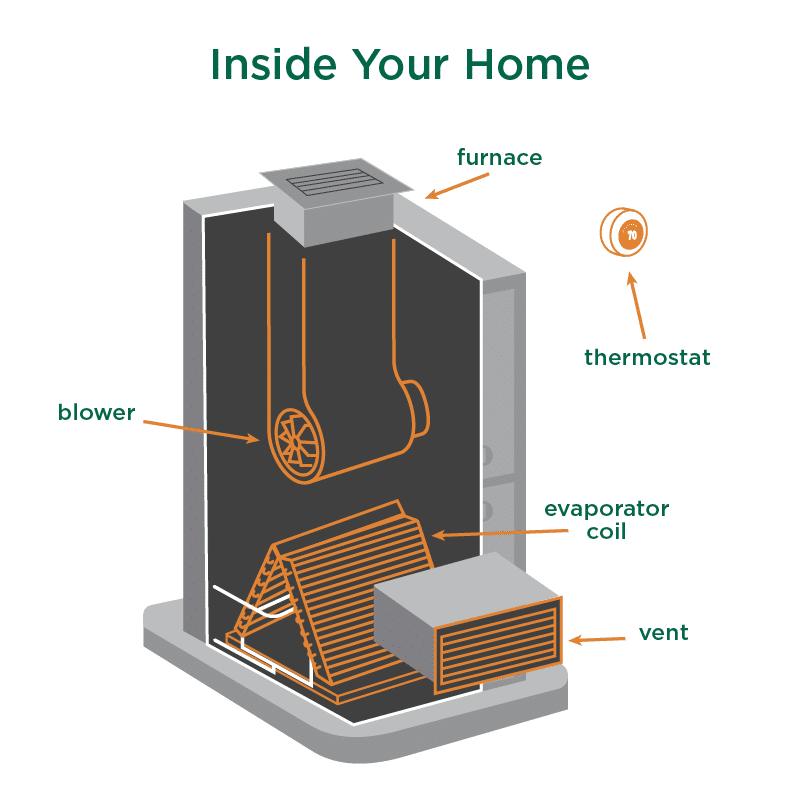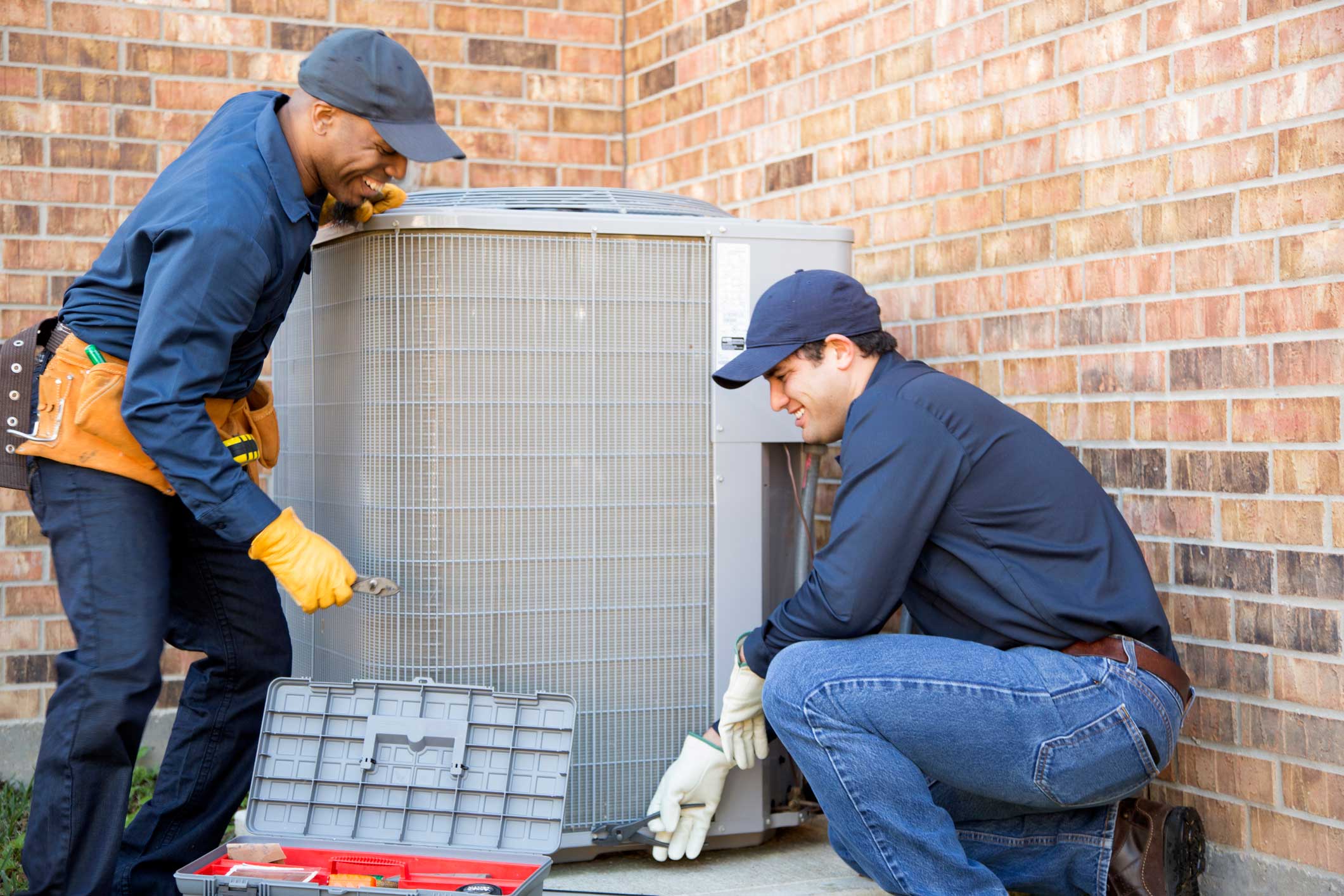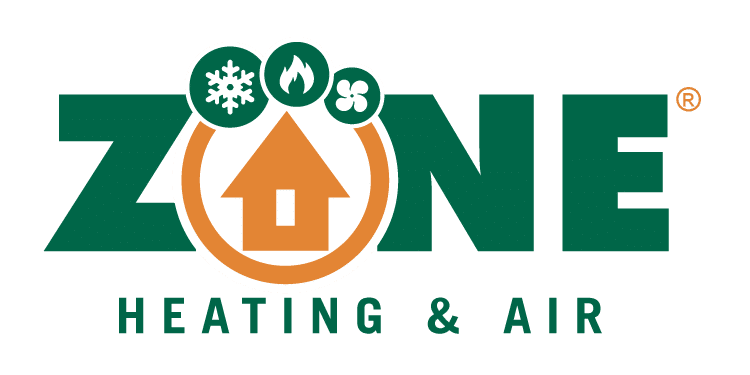As a homeowner, keeping up with all the systems that keep your home comfortable can be overwhelming. One of the systems in a home that can create the most frustration is your HVAC system.
HVAC stands for Heating, Ventilation, and Air Conditioning. Whether in your home or in a business location, your HVAC system provides constant air flow as well as cooling and heating at appropriate times during the year. To accomplish this, an HVAC system uses a variety of moving parts that can easily break down over time.
Inside your home or office are 4 primary parts to your HVAC system.
Your Home’s Internal HVAC System
 The first is the thermostat which allows you to manually or programmatically keep your home at your selected temperature. Modern, smart thermostats are even programmable from your mobile device and can be set to change temperatures at different times of day.
The first is the thermostat which allows you to manually or programmatically keep your home at your selected temperature. Modern, smart thermostats are even programmable from your mobile device and can be set to change temperatures at different times of day.
The second item inside your home is the furnace or heat pump. The furnace or heat pump is typically found within the home, however some homes may have these systems located in a basement, attic, or crawl space. While both the furnace and heat pump serve similar roles, a furnace is gas-powered and a heat pump is powered by electricity. Some systems are even solar-powered! Which one your home has depends on whether you have a gas or electric HVAC system. Either way, both systems heat air in your home and distribute warm air through the ductwork in the home.
The third element that is installed in coordination with your furnace/heat pump within your home is the evaporator coil. The evaporator coil performs the opposite function of the furnace or heat pump and cools air when you set your thermostat to a lower temperature during the spring and summer. This cooler air is then sent through your home via the ductwork.
Now, the last item within your home are the vents. These grates that you see throughout your home serve one of two purposes: some are intake vents bringing air from inside your home, through your home’s air filter, internal HVAC fan, and internal units (furnace/heat pump & evaporator coils) to heat/cool the air and other vents expel air (known as exhaust vents) which send either heated or cooled air through your home. The channels or piping that your HVAC system uses to distribute air to those vents is known as ductwork.
Typical Internal System Issues
When it comes to the HVAC system within your home, there are a lot of opportunities for success – and for problems. Forget to change your air filter frequently enough? If your air filter becomes clogged, it can prevent air from being pulled from inside your home, causing the evaporator coils to not receive enough air and cause your HVAC internal system to freeze. Also, a dirty air filter can cause your HVAC system to have to work harder than necessary and cause your energy bill to skyrocket. Forget to install an air filter? That can be even worse as dirt and debris can clog your evaporator coils and heat pump, causing the system to break down rapidly.
There are a number of other possible issues. If furniture blocks vents it can prevent intake vents from being able to intake the correct amount of air OR prevent exhaust vents from pushing air into the home. Also, if the ductwork isn’t properly sealed, you can leak warm or cool air into your home’s crawlspace or basement, causing higher energy costs. Or, over time, pests can infiltrate your ductwork, particularly in a crawlspace or attic, and cause further problems. And last, over time, these HVAC systems can break down from use – fan motors, small pin holes in evaporating coils that cause leakage from refrigerant, and a range of other problems can occur as your system ages. These are typical signs of wear and tear on an HVAC system and can be repaired or eventually replaced to increase your HVAC system’s efficiency.
Your Home’s External HVAC System
 While the parts inside the home are critical, there is also your external HVAC unit. The external HVAC unit typically contains two primary parts: the condensing unit and the refrigerant lines. Both of these parts are used primarily to cool the home.
While the parts inside the home are critical, there is also your external HVAC unit. The external HVAC unit typically contains two primary parts: the condensing unit and the refrigerant lines. Both of these parts are used primarily to cool the home.
The condensing unit is filled with refrigerant gas and is cooled thanks to the external fan which expels warm air from the unit. When the refrigerant becomes cooled, it is then pumped to the evaporator coil inside the home via the refrigerant lines to help cool the air inside the home. While this seems like a simple process, there are a number of things that can go wrong.
Typical External System Issues
The external HVAC unit sits outside the home where it is faced with the elements of nature. Hot summers, cold winters, animals, leaves, and other debris can surround an external HVAC system and due to this weathering, these systems break down over time. Small holes can develop in the condenser coils leaking refrigerant, cooling fans can break down due to weathering over time, and other issues easily develop. Fortunately, these external systems are built to last for years with few issues – but issues do develop over time and maintenance and repairs are necessary.
Request a Free Quote
Zone Home Solutions has five locations around the Metro Atlanta area. Contact us to get a free, no obligation project quote for your new HVAC system.
The Language of HVAC
So, let’s say you’re installing a new energy-efficient HVAC system for your home. Your preferred HVAC company starts talking about SEER ratings, MERV ratings, tonnage, and other language you’ve never heard before. What does it mean? All of this can be incredibly confusing – so we’ve put together a number of acronyms and definitions to help you further understand how your HVAC system works. Keep in mind that some of these terms are used for residential installations (which we at Zone specialize in) while others are more commonly used in commercial applications:
- ACH: ACH, or air changes per hour, is the rate air enters and exits a room in one hour. The higher the rate of ACH, the better the ventilation in your home.
- AHRI: AHRI is the Air Conditioning, Heating and Refrigeration Institute which actually determines the SEER ratings for HVAC systems and equipment. This organization is an independent organization that simply ensures that the manufacturer’s claims on efficiency are accurate.
- AFUE: Remember how we discussed the difference between an electric and gas heating unit? The AFUE, or Annual Fuel Utilization Efficiency, is simply the measure of efficiency of a gas furnace when it converts gas to energy to heat the home or business.
- CAV: CAV stands for constant air volume, and is a type of HVAC system. CAV systems are typically used in commercial HVAC systems – or those systems for larger businesses. With a CAV unit, the supply airflow rate is constant while the air temperature itself may vary. These systems are great for commercial purposes in areas where there is less variation in the air temperature.
- EER
- FCU: An FCU, or fan coil unit, is a simple HVAC system that blows air across a coil to heat or cool a room. These systems don’t use ductwork, so think of them as like a portable air conditioner or even space heater of sorts. They’re available in floor-mounted or freestanding designs and can also be mounted in a ceiling.
- FAF: FAF, or fresh air fraction, is the ratio of outdoor air intake and the total airflow supply rate.
- HSPF: HSPF, or heating seasonal performance factor, measures the efficiency of a heat pump. Here, the HSPF rating of an HVAC unit simply describes its energy efficiency – the higher the rating, the more efficient.
- MAU: MAUs, or makeup air units, are usually used where high indoor air quality is paramount. An MAU is a large air handler that heats and cools fresh air for a given building.
- MERV: No, Merv isn’t the name of your technician (although it could be!). MERV stands for Minimum Efficiency Reporting Value. This is the standard used to rate the efficiency of the air filters used in your HVAC unit. If you want higher levels of filtration, choose filters with high MERV ratings. Good filtration is important – but remember that some older HVAC systems may struggle with high rates of filtration due to declining air flow. Newer systems tend to handle highly rated MERV filters better than older systems.
- NATE: NATE stands for North American Technician Excellence, NATE is the primary certification program for HVAC professionals and should be a qualifier when selecting your HVAC partner.
- RTU: An RTU is a rooftop unit typically used in commercial applications. You see these frequently in shopping centers, restaurants, stores, etc.
- SEER: SEER stands for Seasonal Energy Efficiency Ratio. So, in laymen’s terms it’s how efficiently does your HVAC system cool the air when the outside temperature reaches a particularly level. The higher the SEER rating is, the more efficiently your HVAC system cools the air.
- Ton or AC Tonnage: In HVAC, a ton, also known as tonnage, is the cooling capacity of your system’s air conditioner. This is actually measured in British Thermal Units – otherwise called BTUs. One ton of air conditioning can remove 12,000 BTUs of heat per hour. The tonnage of your HVAC system is critical as it determines what you will need to adequately cool your home or business. So, you’re likely to hear your HVAC company say you need a “3 and a half ton” or “4 ton” unit. They’re referring to what it takes to cool your home or business. Also note here that just because a unit is larger – that doesn’t mean it’s better. An HVAC unit that is oversized for a home can turn on / turn off too often and cause unnecessary work for the system while a system that is undersized will run too frequently – both problems causing the system to break down earlier than is recommended for the lifetime of the unit.
- British Thermal Units or BTUs for short: A BTU is the amount of energy – that is heat – needed to raise one pound of water 1°F at sea level.
- VAV: a VAV is actually a type of HVAC system. CAV units – as mentioned above – vary the airflow at a constant temperature. VAV units are built to actually allow exact temperature control. The also use less energy and can reduce fan noise.
For a full list of HVAC acronyms, visit this site.
Who to Call When Your HVAC System Doesn’t Work
Founded in Buford, GA, Zone has 5 locations – Atlanta, Buford, Cumming, Hoschton, & Kennesaw – throughout the metro Atlanta area offering heating and air conditioning services through Zone Home Solutions and pest control services through Zone Pest Solutions. Zone provides high-quality customer service (with over 2,000 online reviews) and can help you maintain your home’s HVAC system through HVAC repair, ongoing maintenance, or even HVAC installation of a new Carrier system. Contact us or schedule an appointment today or call 770-904-5432.
Ready to Save More? Schedule Your HVAC Maintenance Today!


